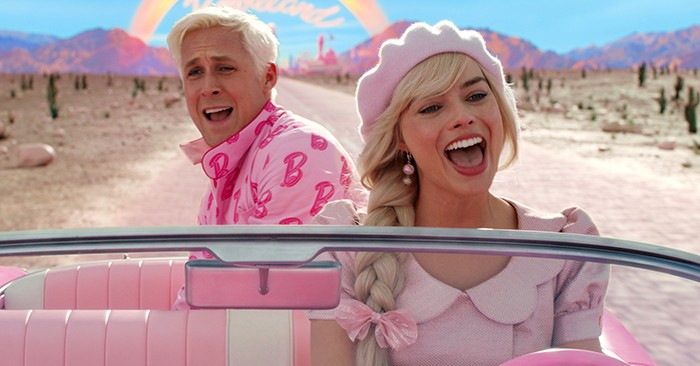“Have you seen the Barbie movie yet, Mike?” Every time I bumped into a certain Salvation Army officer at territorial headquarters over the past few months, he asked me this question.
When he first asked, I had no interest in seeing the film. Unlike some people—mostly male— my lack of interest wasn’t rooted in misplaced indignation that a film existed that didn’t explicitly target me and my interests and wasn’t populated by actors who look like me. I just didn’t think it was for me.
I’ve long respected the creative team behind the fantasy-comedy Barbie. Director Greta Gerwig and her co-writer and partner Noah Baumbach have an established track record of thoughtful and thought-provoking independent movies, such as The Squid and Whale (2005), Frances Ha (2012), Lady Bird (2017), and the exceptional Little Women (2019). So, while I was genuinely pleased that an original movie was doing so well—when so much of contemporary filmmaking relies on remakes, sequels and franchises—I wasn’t rushing out to the theatre. I figured I’d see the movie when it came out on a streaming service.
But then the officer said, “You should see it. I really think there’s something there.”
Cultural Phenomenon
He was right. There is indeed much there.
Gerwig and Baumbach have managed to explore themes of existential crisis, media perfection, diversity, post-modern (and multigenerational) feminism, creation and purpose, and reactionary politics with humour and style. It’s a film America: The Jesuit Review has called “as layered and paradoxical as the reputation of Barbie itself.”
With record-breaking box office numbers and the pink cosplay party vibe of the initial screenings, Barbie became a cultural phenomenon. The film really spoke to people—as the recent backlash against comedian Jo Koy, who made several dismissive jokes about the film as the host of the 2024 Golden Globes, shows.
As I watched Barbie, I kept thinking about the potential for deep conversations this pink-tinted, plastic-coated, 114-minute narrative, could spark—particularly within Christian circles.
For those who haven’t seen the movie, here’s a brief recap. In the fantastical Barbieland, where many Barbies rule with prestigious jobs and Kens (and an Allen) play at the beach, one Barbie (Margot Robbie) faces an existential crisis. Struggling with mortality and beauty standards, Barbie leaves to find her real-world owner and correct the rift between the two worlds.
Alongside a Ken (Ryan Gosling), Barbie travels to the actual Venice Beach, California, where she is shocked to discover that women are still excluded and objectified. Barbie’s encounter with her world-weary owner, Gloria (America Ferrera), sparks a journey of self-discovery and societal critique. On the other hand, Ken learns about patriarchy and leads a revolution of Kens in Barbieland, challenging gender norms.
Through Gloria’s assistance, the Barbies reclaim power and resolve to build a more inclusive society. Barbie becomes human and returns to the real world as “Barbara Handler.” With support from Gloria, Gloria’s cynical daughter, Sasha (Ariana Greenblatt), and Ken, Barbie embraces her evolving identity, marking a new chapter in her story.
Perfect in Plastic
One of the relevant issues Barbie raises for conversations happening in the church is the representation of Barbieland itself and the perceived idealization of that world. To be clear, I don’t think the filmmakers are intentionally comparing Barbieland to the church. Rather, the way Barbieland is portrayed has some unexpected parallels that could produce a fruitful conversation.
At the beginning of the film, Barbieland seems the perfect place to live, a welcoming world of abundance. At the start of every perfect day, each perfect Barbie wakes in her own perfect Dreamhouse, then greets the other Barbies with a happy, “Good morning, Barbie.” The morning routine is quick and mess-less—the shower doesn’t use actual water and there’s no real food at breakfast.
When Barbie starts to think about her mortality, we see Barbieland’s inability to handle difficulties and hardships. The world itself starts to physically shake in reaction to Barbie’s new difference, so that soon everyone knows there’s a problem, no matter how hard she tries to hide it. For all the apparent diversity among the Barbies (which is mostly just diversity of employment), Barbieland can’t handle real difference of thought. It’s all for show.
I couldn’t help but be reminded of things I’ve heard people say about the church—that one of the reasons they left is because they didn’t feel good enough, because it didn’t feel like a place they could bring their doubts, fears and imperfections. And often they’re right.
When churches are presented as a place for people who have it all together or who all look alike, many feel an inherent, unresolvable tension. Church becomes not a place to worship, but a social club where one must fit in. In churches like that, people don’t feel they can bring the hardships, strife, illness and loss that comes to all of us. They sometimes feel the need to hide those emotions and experiences to maintain the façade of perfection.
Life in Barbieland
At the movie’s conclusion, Barbieland doesn’t simply “go back to the ways things were.” Rather, it changes to create space for those who had previously been silenced: the marginalized “Weird Barbie,” whose badly cropped hair and physical disabilities set her apart from the other dolls, and the Kens, who are now included in governance and decision-making.
The filmmakers recognize—as church leaders must recognize—that there is no “going back” to any previous state. Institutions and societies must continue to evolve, adapt and assess themselves and how they operate in light of new people, who will introduce new thoughts, experiences and expectations, as well as new challenges.
Dr. Michael W. Boyce is the director of program implementation at the College for Officer Training in Toronto.
Photo: Courtesy of Warner Bros. Pictures










Leave a Comment